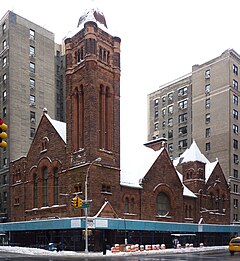West-Park Presbyterian Church
| West-Park Presbyterian Church | |
|---|---|

View from the corner of Amsterdam Avenue and 86th Street
|
|
| General information | |
| Architectural style | Richardsonian Romanesque / Romanesque Revival |
| Town or city | New York, New York |
| Country | United States of America |
| Construction started | 1889 |
| Completed | 1884, 1890 |
| Cost | ? (1884), $100,000+ (1890) |
| Client | The Presbytery of New York |
| Technical details | |
| Structural system | Brown and red sandstone masonry |
| Design and construction | |
| Architect | Leopold Eidlitz, Henry Franklin Kilburn |
| Engineer | ? |
| Website | |
| www.westparkpresbyterian.org | |
West-Park Presbyterian Church is a Romanesque Revival Presbyterian church located on the corner of Amsterdam Avenue at 86th Street on Manhattan's Upper West Side, New York City, consisting of a main sanctuary and chapel.
The congregation was founded in 1852 as the 84th Street Presbyterian Church, building its first chapel of timber in 1854 on 84th Street and West End Avenue, to designs by one of the city’s most prominent architects, Prague-born Leopold Eidlitz. The church changed its name to Park Presbyterian Church in 1887. The name became West-Park Presbyterian when the midtown West Presbyterian Church (New York City) (founded 1829) merged with Park Presbyterian in 1911.
The small congregation moved north in uptown Manhattan a number of times. Upon moving to the Upper West Side, one wealthy new pastor (from 1879), Anson Phelps Atterbury (1855–1931), proposed a grand church in the hopes that the congregation would expand with the expected increases to the neighborhood that the new IRT lines along Broadway would bring. That pastor commissioned Leopold Eidlitz to build a diminutive midblock brick Romanesque Revival chapel in 1884, a style Eidlitz described as "muscular" Romanesque and considered appropriate to an evangelical Protestant church. After a further $100,000 was raised, the main sanctuary was built in 1889-90 on the abutting corner site, to designs by Henry Franklin Kilburn in intricately carved brown and red sandstone in a stylistic continuation of Eidlitz's Romanesque chapel but re-cladding that brick chapel in sandstone and adding an offset diminutive tower. The corner features a giant ribbed bell-domed belltower, which dominates the neighborhood and if not for the competing heights of apartment towers “would be one of the West Side’s loveliest landmarks,” according to the AIA Guide to NYC.
...
Wikipedia
